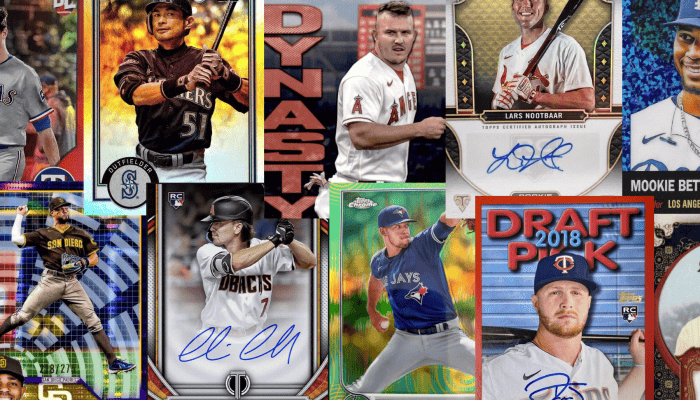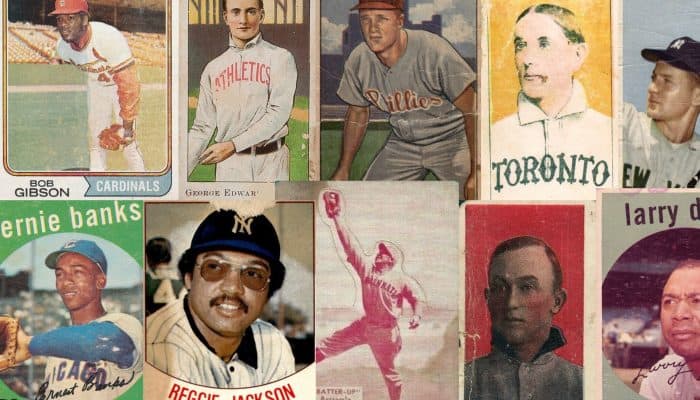
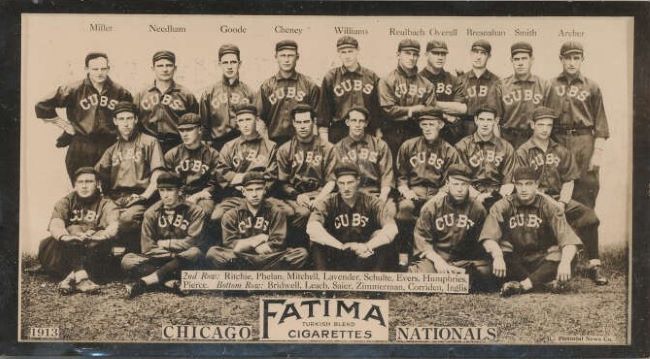
The Chicago Cubs are one of the most iconic franchises in Major League Baseball, with a storied history that stretches back over a century. Established in 1870 as the Chicago White Stockings, the team later underwent a series of name changes, becoming the Chicago Colts in 1890 and finally adopting the name we know them by today, the Chicago Cubs, in 1903.
The Cubs have a rich baseball heritage, with their most significant achievement being the capture of three World Series championships in 1907, 1908, and 2016. The 108-year championship drought between 1908 and 2016 became the stuff of legend, making their 2016 victory all the more momentous.
Wrigley Field, the historic ballpark they call home, stands as a symbol of the team’s enduring significance in the world of baseball, and the Cubs’ dedicated fan base, known as the “Cubs Nation,” remains unwavering in its support, making them a truly beloved and iconic institution in the heart of Chicago and beyond.
Here are the top 10 Cubs players of all-time and one must-have card for each player:
10. Mordecai Brown
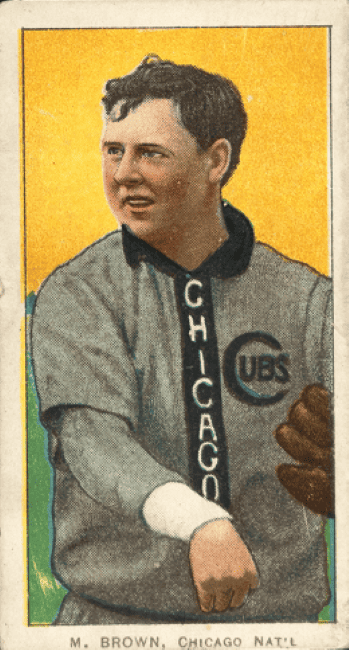
Mordecai “Three Finger” Brown was a legendary pitcher who spent the majority of his career with the Chicago Cubs from 1904 to 1912.
Brown is renowned for his unique pitching style, as he had only three fingers on his right hand due to a childhood accident. As a result, he developed a unique curveball grip using his partially amputated finger, which allowed him to create exceptional movement on the pitch. This innovation played a significant role in his pitching success and contributed to his legendary status.
Brown was an integral part of the Cubs’ championship-winning teams in 1907 and 1908, and he played a crucial role in their pitching staff. Brown made history as the pitcher who recorded the final out in the Chicago Cubs’ first-ever World Series victory in 1907, when the Cubs defeated the Detroit Tigers.
His statistics are impressive, including six seasons with an ERA under 2.00. Brown’s mastery of the curveball, along with his impeccable control, made him a feared opponent on the mound. He threw a remarkable 59 complete games between 1909-1910, a feat unheard of today.
After retiring from baseball, Brown served as a coach and scout for several teams, including the Chicago Cubs and St. Louis Cardinals. He continued to contribute to the game’s development and shared his vast knowledge and expertise with younger generations of players.
Brown’s unique story and extraordinary pitching abilities continue to captivate baseball fans to this day. He was inducted into the Baseball Hall of Fame in 1949.
Best Cubs card: 1909-1911 Piedmont T206 Mordecai Brown
Brown was included in some great early sets, including the Sporting Life cabinets and American Life, but the T206 is often referred to as the holy grail of card sets. Brown has several T206 cards, but the most popular shows him in a Chicago jersey, following through his pitching motion. The highest grade recorded is one PSA 8, valued by PSA at $5,500. The most common grades are PSA 3 and PSA 4, and those typically cost $150-$300.
9. Stan Hack
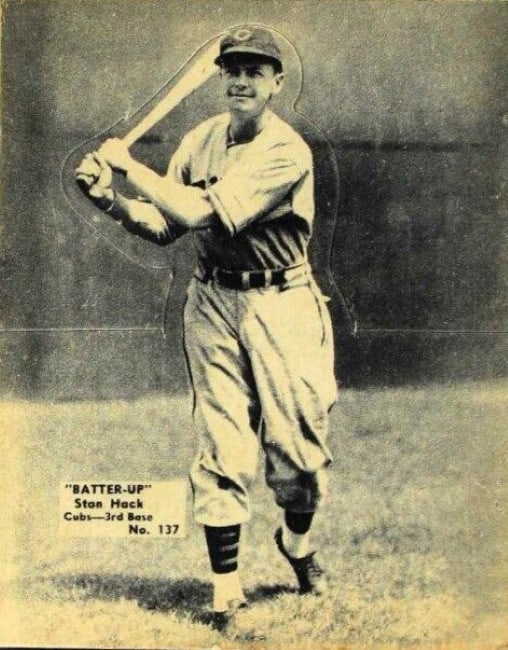
Stan Hack was a talented third baseman who spent his entire 16-year Major League career with the Chicago Cubs from 1932 to 1947. He was a consistent and reliable presence in the Cubs’ lineup and a stellar defender at the hot corner. Hack was known for his ability to get on base and make contact, making him a valuable asset for the Cubs throughout his career.
Hack’s tenure with the Cubs was marked by impressive offensive consistency. He led the National League in hits in 1938 and 1939. He was also a five-time All-Star during his career and finished in the top 20 of MVP voting an impressive seven times. After retiring after the 1947 season, Hack returned as manager from 1954-1956, where he managed stars like Ernie Banks.
Hack played 1,938 games at third base for the Chicago Cubs, a franchise record that still stands today. He also holds the Major League record for the most career putouts by a third baseman. Hack was a defensive stalwart, consistently making plays at the hot corner. His impact on the Cubs’ success and his remarkable consistency throughout his career make him a notable figure in the team’s history.
Best Cubs card: 1934-1936 National Chicle Batter Up #137 Stan Hack
Stan Hack is a criminally underrated player, so he doesn’t have a lot of baseball cards available. Those that are out there are typically from his post-playing career. The 1934 Batter Up card is technically his rookie, although that’s not the most important thing about it. The Batter Up set is one of the more popular sets from this time period, featuring a die-cut player on the front. In excellent condition, graded versions sell for approximately $100-$200, with ungraded or poor conditions available for significantly less.
8. Fergie Jenkins
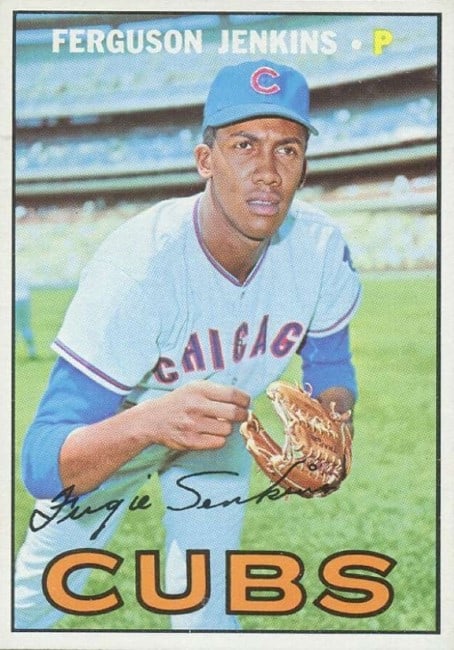
Fergie Jenkins was a dominant pitcher who spent a significant part of his illustrious career with the Chicago Cubs. He joined the Cubs in 1966 and remained with the team until 1973.
During his tenure with the Cubs, Jenkins was a consistent and reliable ace who excelled on the mound. He was known for his pinpoint control and an impressive arsenal of pitches. Jenkins won the National League Cy Young Award in 1971, becoming the first Cubs pitcher to receive this prestigious honor. That year, he posted a remarkable 24-13 record with a 2.77 ERA, showcasing his dominance on the mound.
Jenkins was not only an exceptional pitcher but also a durable workhorse, regularly exceeding 300 innings pitched in a season. He also led the league in complete games four times, in 1967, 1970, 1971 and 1974.
In six consecutive seasons from 1967 to 1972, he won at least 20 games, showcasing his consistency as a top-tier pitcher. He was also a three-time All-Star as a member of the Cubs and remains the franchise’s all-time leader in wins, strikeouts, and complete games. Jenkins finished his career with 284 wins, good for 29th all-time in Major League Baseball.
Fergie Jenkins was a key figure in the Cubs’ pitching staff during his time with the team, and his contributions to the franchise’s success have not been forgotten. He was inducted into the Baseball Hall of Fame in 1991, further solidifying his place in baseball history as one of the game’s greatest pitchers.
Best Cubs card: 1967 Topps #333 Fergie Jenkins
This is Jenkins’s first Cubs card, and the coloring and design are great examples of 1960s Topps cards. The card includes a facsimile autograph above a large “CUBS” title. Jenkins was a prolific signer, so many autographed versions of this card also exist. Expect to pay around $150-$200 for a PSA 8 or PSA 9, or about $75 for a near mint, ungraded version.
7. Gabby Hartnett
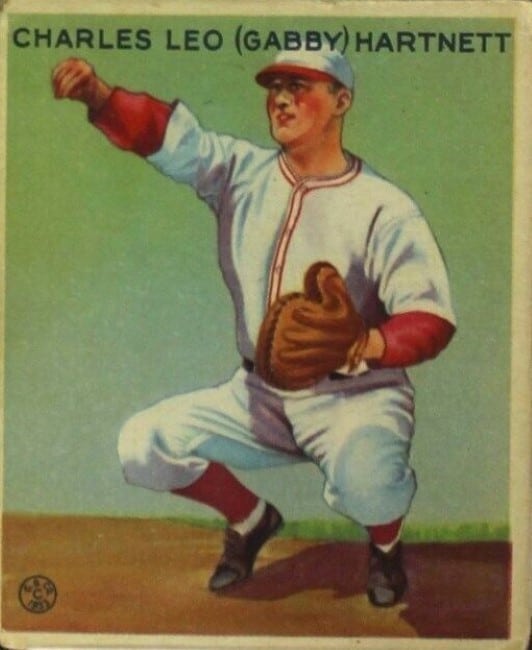
Gabby Hartnett was a legendary catcher who spent the majority of his career with the Chicago Cubs. He played for the Cubs from 1922 to 1940 and then returned for a brief stint in 1946. During his time with the Cubs, Hartnett became one of the most iconic figures in the franchise’s history. He was known for his excellent defensive skills and clutch hitting, earning the nickname “Old Tomato Face” for his fiery demeanor on the field.
Hartnett’s career with the Cubs was highlighted by his role in the infamous “Homer in the Gloamin'” game in 1938. In the bottom of the ninth inning with fading light, he hit a walk-off home run that helped the Cubs clinch the National League pennant. This moment is etched in Cubs history as one of the most iconic and memorable plays ever.
As player-manager in 1938, Hartnett was the last manager to lead the Chicago Cubs to a National League pennant, before the team won the World Series in 2016. His contributions as a player-manager are a testament to his versatility and influence within the organization.
As a player, Hartnett was a five-time All-Star and National League Most Valuable Player (MVP) in 1935. He was also an excellent handler of pitchers, guiding many of the Cubs’ legendary pitchers to success. He played 1,793 games as a catcher, which is 15th all-time.
Gabby Hartnett was inducted into the Baseball Hall of Fame in 1955, cementing his legacy as one of the greatest catchers in the history of the game.
Best Cubs card: 1933 Goudey #202 Gabby Hartnett
This set is already legendary, but the choice to depict Hartnett in the catching position, showing off his defensive prowess, makes it a home run. The Goudey set is very popular with collectors, and the cards are relatively easy to find on the secondary market. Hartnett’s card is around $1,000 for a PSA 4 or PSA 5, rising to mid-four figures for a better grade.
6. Billy Williams
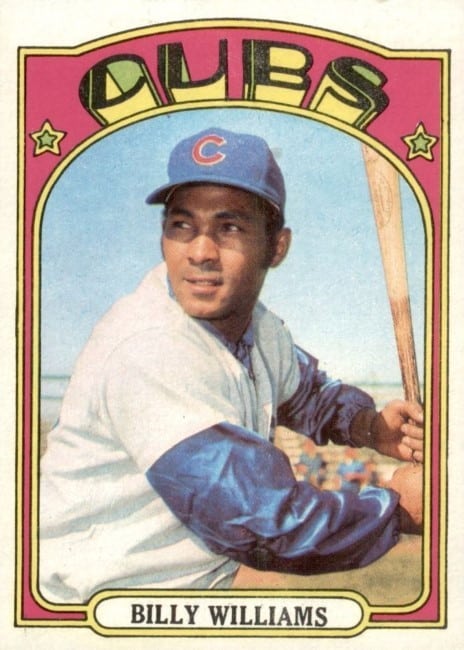
Billy Williams, affectionately known as “Sweet Swinging Billy,” is one of the most accomplished outfielders in Chicago Cubs history. He was known for his smooth, left-handed swing and ability to consistently make contact with the baseball. His career with the Cubs, which extended from 1959 to 1974, is marked by consistent excellence at the plate and numerous accolades. Williams was a six-time All-Star and the 1961 National League Rookie of the Year.
Williams was renowned for his smooth left-handed swing and his ability to hit for both power and average. He finished his Cubs career with a batting average of .296 and 392 home runs. In 1970, when he was runner-up in MVP voting, he led the league in hits, runs and games played. In fact, Williams was known for his durability. He played in 1,117 consecutive games for the Cubs from 1962 to 1971. This iron man streak showcased his consistency and commitment to his team.
Williams was a quiet superstar, who put up more hits than Mickey Mantle or Ted Williams, and more home runs than Duke Snider or Johnny Bench. Yet, he is lesser known than all of those players. Said Williams: “People say I’m not an exciting player. I go out there and catch the ball and hit the ball and play the game like it should be played.”
After retiring as a player, Billy Williams stayed connected to the game by working as a Cubs coach. He served as a coach for the Cubs from 1983 to 1987 and later as a hitting instructor, sharing his wealth of knowledge and experience with the team. Billy Williams was inducted into the Baseball Hall of Fame as a player in 1987.
Best Cubs card: 1972 Topps #439 Billy Williams
Williams won the batting title in 1972, and this card is a fitting combination of 1970s Topps style and a landmark year for the humble Cub. The card is affordably priced at around $200 for a PSA 10, and between $10-$15 for an ungraded version.
5. Sammy Sosa
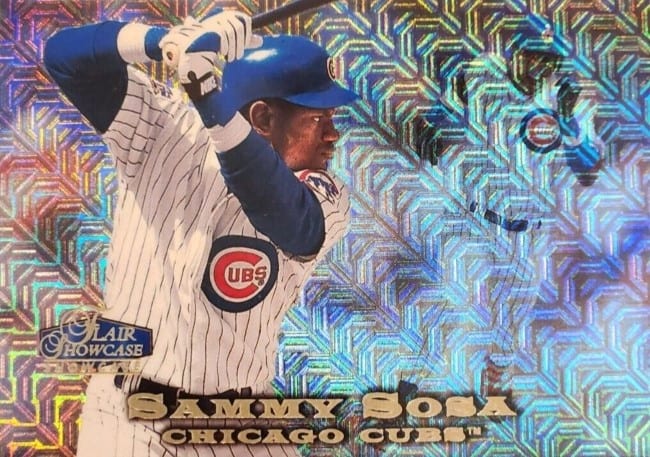
Sammy Sosa, known for his electrifying power and charismatic persona, left an indelible mark on the Chicago Cubs during his time with the team from 1992 to 2004. Sosa’s prolific career as a Cub is highlighted by his remarkable power hitting. He won the National League Most Valuable Player (MVP) award in 1998, when he hit an astonishing 66 home runs, captivating fans and the entire baseball world.
Sosa was a seven-time All-Star during his Cubs career. He led the league in home runs in 2000 and 2002, solidifying his status as one of the premier power hitters of his era. Sosa’s 66 home runs in 1998 came in the same season that his NL Central foe, Mark McGwire, hit a record 70 home runs in a season that captivated fans. He has a career total of 609 home runs, which is 9th all-time. He finished in the top 10 of MVP voting in six of his 13 seasons with the Cubs.
Sosa’s career accomplishments are tainted by a failed drug test in 2003, which revealed performance-enhancing drugs (PEDs). However, he has consistently denied using any illegal substances. Due to the backlash against players from this era who may have used PEDs, Sosa has not been elected to the Hall of Fame.
Best Cubs card: 1998 Flair Showcase Row 0 #91 Sammy Sosa
Nothing encapsulates 1990s baseball like the Sosa-McGwire home run chase, so it’s fitting that Sosa’s best card would be a classic 90s design like the 1998 Flair Showcase. Sosa is primed and ready to hit one of his famous home runs.
4. Ron Santo

Ron Santo was a beloved figure in Chicago Cubs history, renowned for his exceptional skills as a third baseman and his unwavering commitment to the team. Santo’s career with the Cubs spanned from 1960 to 1973, during which he became one of the most iconic players in the franchise’s history. He was a nine-time All-Star, and his defensive prowess at the hot corner was widely respected.
Santo’s offensive contributions were equally impressive. He had a career batting average of .277 and hit 342 home runs as a Cub, making him one of the most potent offensive threats at his position. In 1967, he led the league in on-base percentage and was a significant run producer for the Cubs. Despite his individual achievements, Santo, like many Cubs greats, never won a World Series with the team. Nevertheless, his dedication to the Cubs and his passion for the game endeared him to fans.
Santo was also an inspiring presence off the field. Diagnosed with juvenile diabetes at the age of 18, Santo initially hid the disease from his team. However, in his later career he went public, showing people that it was possible to achieve great things even with the disease.
Ron Santo passed away in 2010 and was posthumously inducted into the Baseball Hall of Fame in 2012.
Best Cubs card: 1965 Topps Card #110 Ron Santo
Printing processes improved steadily, and in the 1960s card designs and technology were starting to click. Although Santo’s 1961 Topps rookie card is an obvious choice, the 1965 Topps card has a far more iconic design. It features the cubs logo and name in a pennant at the bottom of the card, and a vibrant red border. Prices for a PSA 8 or PSA 9 are approximately $100-$200.
3. Cap Anson
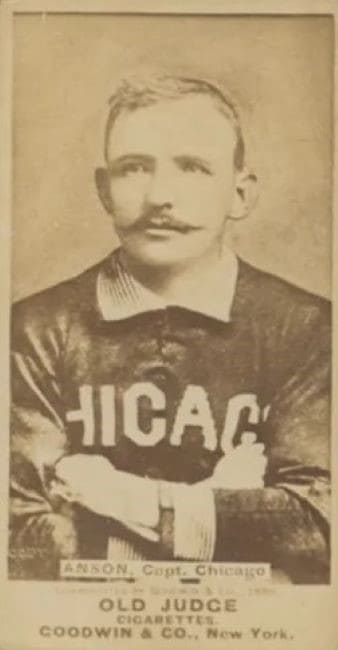
Adrian Constantine Anson, nicknamed “Cap” for “Captain,” played a pivotal role in the early years of the Chicago franchise. He was known for his exceptional hitting and a no-nonsense leadership style on and off the field. Anson’s Cubs career extended from 1876 to 1897, and during this time, he achieved a number of notable accomplishments.
Anson was primarily a first baseman and was the Cubs’ first true superstar. In an era before the modern home run was common, Anson’s impressive batting average and ability to get on base were highly regarded. He led the National League in batting average six times and in RBIs eight times. Anson’s consistency at the plate made him a formidable force in the league. He was a key player in the Cubs’ success during the late 19th century, helping the team win five National League championships (1880, 1881, 1882, 1885, and 1886).
Apart from his on-field achievements, Cap Anson was known for his leadership and influence in the early days of professional baseball. He was a player-manager for much of his Cubs career, making strategic decisions on the field. He is credited with inventing the pitching rotation and signaling to his players.
Unfortunately, Anson’s authority was also integral in racial segregation in the early days of baseball, which persisted long after his death in 1922. There are numerous stories of Anson refusing to play with Black players and, as he moved into a managerial role, he also refused to give contracts to Black players. While this was not an isolated opinion at the time, his status with the league caused an outsized influence on keeping Black players out of Major League Baseball.
For his on-field achievements, Anson is acknowledged as one of the most accomplished Cubs players in their history. He was inducted into the Hall of Fame in 1939.
Best Cubs card: 1887 Old Judge N172 #11-2a Cap Anson
1887 was the first year you can find cards for Anson. His best – and also his most valuable – is the 1887 Old Judge N172. One of four different prints, the most expensive is the “Chicago uniform” version, as other Anson poses show him in street clothes. Only a few are known to exist, and PSA has logged a PSA 8 for $150,000. For a more affordable option (relatively speaking), the 1888 Allen & Ginter N28 is worth a look at around $24,000 for a PSA 8.
2. Ryne Sandberg
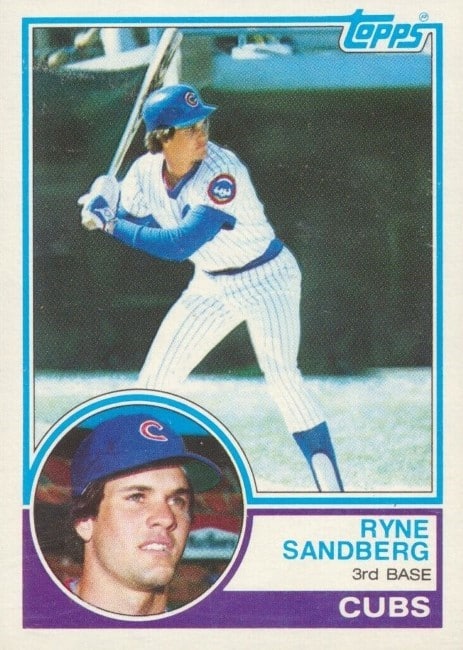
Ryne Sandberg, often simply called “Ryno,” is one of the most celebrated players in Chicago Cubs history. He had a distinguished career as a second baseman with the Cubs, earning a reputation as one of the best defensive players at his position and a powerful offensive threat. Sandberg’s time with the Cubs, spanning from 1982 to 1994 and then from 1996 to 1997, is marked by numerous accolades and memorable moments.
Sandberg was a 10-time All-Star and won nine Gold Glove Awards during his career. His defensive prowess at second base was legendary, and he was known for making acrobatic plays and turning double plays with precision. Sandberg’s offensive contributions were equally impressive, and he was a versatile hitter with power. He won the National League MVP award in 1984 when he batted .314, hit 19 home runs, and stole 32 bases. He consistently ranked among the league’s top players in home runs and RBIs.
Although the Cubs didn’t secure a World Series championship during Sandberg’s time with the team, he left an indelible mark on the franchise. He was known for his quiet leadership and led by example. Sandberg was inducted into the Baseball Hall of Fame in 2005, cementing his status as one of the all-time greats. In 2010, the Cubs honored him by retiring his jersey number 23, recognizing his immense contributions to the team. Ryne Sandberg’s legacy as a Cubs legend remains strong, and he is remembered as one of the finest second basemen in the history of the sport. He was elected to the Hall of Fame in 2005.
Best Cubs card: 1983 Topps #83 Ryne Sandberg
Sandberg played from 1981-1997, so there are plenty of rookie cards and inserts to choose from. His best rookie, though, is his 1983 Topps. While some collectors prefer the clean design of his Fleer and Donruss rookies, the 1983 Topps design is instantly recognizable. Prices vary widely, but expect to pay around $300-$500 for a gem mint PSA 10.
1. Ernie Banks
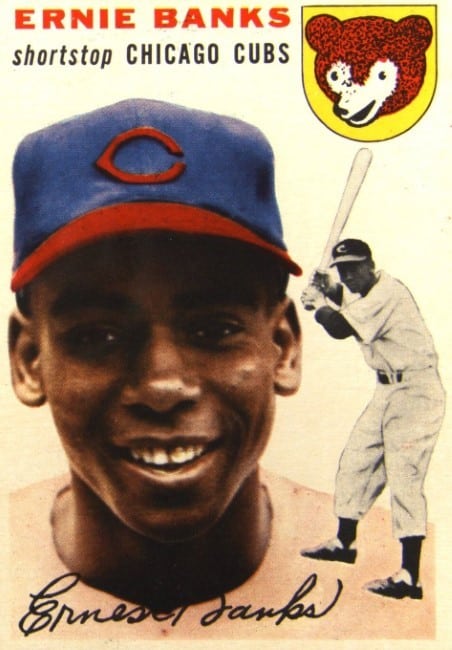
Ernie Banks, affectionately known as “Mr. Cub,” is a legendary figure in the history of the Chicago Cubs. He spent his entire 19-season career with the Cubs, making a significant impact on the team and the city of Chicago. Banks was primarily a shortstop and first baseman, and he is celebrated not only for his skills on the field but also for his infectious enthusiasm for the game.
Banks’s career with the Cubs spanned from 1953 to 1971, and he achieved numerous milestones during his time with the team. He was a 14-time All-Star and a two-time National League Most Valuable Player (MVP) in 1958 and 1959. His offensive prowess was highlighted by his 512 career home runs, making him one of the most prolific power hitters in the history of the Cubs. He led the National League in home runs in 1958 and 1960, cementing his status as one of the premier sluggers of his era. Additionally, Banks was known for his consistency, recording over 100 RBIs in eight seasons and over 30 home runs in five seasons.
While Banks’s individual accolades were impressive, he was never fortunate enough to win a championship with the Cubs. The team struggled during his tenure, often finishing near the bottom of the standings. Nonetheless, Banks remained a beloved figure in Chicago, and his positive attitude and unwavering love for the game endeared him to fans. He is known for the phrase, “Let’s play two!” showing his infectious attitude toward baseball.
In 1977, the Cubs retired his jersey number 14, a testament to his enduring impact on the franchise. Ernie Banks passed away in 2015, leaving behind a legacy as one of the greatest Cubs players of all time. He was inducted into the National Baseball Hall of Fame in 1977.
Best Cubs card: 1954 Topps #94 Ernie Banks (RC)
For Ernie Banks, you can’t beat the 1954 Topps, which shows the 23 year old on his first baseball card. The design is retro but memorable, and features a facsimile autograph at the bottom. Like Jenkins, Banks was a prolific signer, so many autographed versions of this card also exist. For a graded version in excellent condition, expect to pay around $6,000-$7,500.
